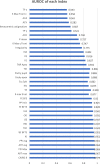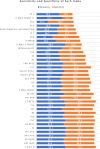Diagnostic accuracy of different keratoconus detection indices of pentacam in paediatric eyes
- PMID: 35505110
- PMCID: PMC10102329
- DOI: 10.1038/s41433-022-02070-x
Diagnostic accuracy of different keratoconus detection indices of pentacam in paediatric eyes
Abstract
Objective: No diagnostic gold standard for keratoconus in children and adolescents exists. Our objective was investigating the diagnostic accuracy of various indices for keratoconus (KC) detection in paediatric eyes.
Methods: All retrievable data of significance from 432 normal right paediatric eyes and 48 eyes of paediatric KC and forme fruste KC (FFKC), imaged by use of a rotating Scheimpflug camera (Oculyzer II, Pentacam HR) between December 2013 and October 2018 at Watany Eye Hospitals, Cairo, Egypt, including Scheimpflug images data, were collected. The area under the receiver operating characteristic curve (AUROC) was calculated for different indices in this retrospective descriptive study.
Results: All 36 tested indices showed discriminative power differentiating KC and FFKC from normal corneas (AUROC P-value <0.05), except AC volume, AC angle, and horizontal decentrations of the steepest and thinnest points. The 32 indices showed variable degrees of diagnostic accuracy. The highest AUROC was that of the corneal assessment index from the relational thickness and other OCULUS values (CAIRO 8). Only 8 indices showed non-inferiority to it, namely, Ambrosio's relational thickness maximum (ART max) and avg, the pachymetric progression index maximum (PPI max) and avg, the back elevation from the best-fit toric ellipsoid (BE BFTE), the KC index (KI), the topographic KC indices (TKC), and the index of height decentration (IHD) (P > 0.05).
Conclusions: The 8 most useful rotating Scheimpflug imaging indices for KC detection in paediatric eyes are CAIRO 8 followed by ART max and avg, PPI max and avg, BE BFTE, KI, TKC, and IHD.
© 2022. The Author(s).
Conflict of interest statement
The authors declare no competing interests.
Figures



Similar articles
-
Rotating Scheimpflug Imaging Indices in Different Grades of Keratoconus.J Ophthalmol. 2016;2016:6392472. doi: 10.1155/2016/6392472. Epub 2016 Aug 8. J Ophthalmol. 2016. PMID: 27579178 Free PMC article.
-
Early, Forme Fruste keratoconus and normal thin cornea, evaluation of sensitive parameters by combined Placido Scheimpflug topography.Eur J Ophthalmol. 2024 Jan;34(1):59-70. doi: 10.1177/11206721231199506. Epub 2023 Sep 20. Eur J Ophthalmol. 2024. PMID: 37731321
-
Objective and subjective diagnostic parameters in the fellow eye of unilateral keratoconus.BMC Ophthalmol. 2017 Oct 6;17(1):186. doi: 10.1186/s12886-017-0584-2. BMC Ophthalmol. 2017. PMID: 28985735 Free PMC article.
-
Scheimpflug-Derived Keratometric, Pachymetric and Pachymetric Progression Indices in the Diagnosis of Keratoconus: A Systematic Review and Meta-Analysis.Clin Ophthalmol. 2023 Dec 20;17:3941-3964. doi: 10.2147/OPTH.S436492. eCollection 2023. Clin Ophthalmol. 2023. PMID: 38143558 Free PMC article. Review.
-
Advances in machine learning for keratoconus diagnosis.Int Ophthalmol. 2025 Mar 30;45(1):128. doi: 10.1007/s10792-025-03496-4. Int Ophthalmol. 2025. PMID: 40159519 Free PMC article. Review.
Cited by
-
Evaluation of parameters for early detection of pediatric keratoconus.BMC Ophthalmol. 2024 Oct 21;24(1):463. doi: 10.1186/s12886-024-03714-0. BMC Ophthalmol. 2024. PMID: 39434060 Free PMC article.
-
The Combined Utilization of Epithelial Thickness Mapping and Tomography in Keratorefractive Surgery Screening: One Imaging Modality is Not Sufficient.Clin Ophthalmol. 2023 May 24;17:1457-1463. doi: 10.2147/OPTH.S404019. eCollection 2023. Clin Ophthalmol. 2023. PMID: 37251984 Free PMC article.
-
Corneal topographic indices of scheimpflug camera in type 2 diabetic and non-diabetic elderly populations.BMC Ophthalmol. 2023 Oct 23;23(1):427. doi: 10.1186/s12886-023-03169-9. BMC Ophthalmol. 2023. PMID: 37872473 Free PMC article.
-
Machine learning analysis with the comprehensive index of corneal tomographic and biomechanical parameters in detecting pediatric subclinical keratoconus.Front Bioeng Biotechnol. 2023 Dec 6;11:1273500. doi: 10.3389/fbioe.2023.1273500. eCollection 2023. Front Bioeng Biotechnol. 2023. PMID: 38125302 Free PMC article.
-
Repeatability and agreement of two ocular biometers with single and dual Scheimpflug cameras in keratoconus eyes.Graefes Arch Clin Exp Ophthalmol. 2024 Nov;262(11):3701-3709. doi: 10.1007/s00417-024-06511-z. Epub 2024 Jul 24. Graefes Arch Clin Exp Ophthalmol. 2024. PMID: 39046518
References
MeSH terms
LinkOut - more resources
Full Text Sources

